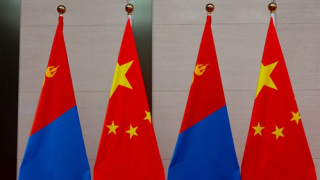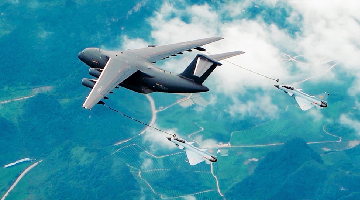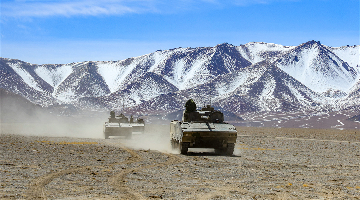
By Guo Yuandan
The movements of the PLA Navy Liaoning aircraft carrier task force have recently been closely watched. A photo circulated in western media on April 11 showed that the guided-missile destroyer USS Mustin was shadowing the Liaoning in the Philippine Sea, from which even the carrier-based aircraft onboard were visible. Has the US warship been in dangerous proximity? What does the US Navy aim for by releasing this photo at this time?
This photo posted on the US Navy website showed that two US military officers were “monitoring surface contact” from the deck of the USS Mustin on April 4, not far away from which there was China’s aircraft carrier Liaoning.
On April 5, China’s Liaoning aircraft carrier task force was carrying out training in waters around Taiwan, as confirmed by the PLA Navy. This photo released by the US Navy is proof that the US ship was tracking and monitoring the Liaoning at close range. The Drive, a US website,expressed on April 10 that the sailing of China’s aircraft carrier task force was closely watched by both Japan and the US.
Retired Chinese Navy captain Tian Shichen, vice-president of the Grandview Institution and director of the Centre for International Law of Military Operations in Beijing, told reporters on April 11 that according to the United Nations Convention on the Law of the Sea, military vessels and aircraft of all countries enjoy the freedom of navigation and overflight in the sea and airspace beyond their territorial waters and airspace. “It is quite normal for warships and aircraft between hostile or competing countries, and even those between friendly countries, to track and monitor each other beyond the territorial waters of coastal countries, as long as they comply with international regulations for preventing collision at sea and maintain a safe distance, with a view to avoiding collisions or other accidents,” he said.
In the photo released by the US military, the Chinese and US warships were close to each other. Have the two sides kept a safe distance or been in dangerous proximity? According to professionals, there is no universally accepted technical definition for the safe distance of naval warships, and the most critical factors in determining the distance are the “state of the two ships and the sea conditions at the time.”
According to the rules for collisions avoidance, when encountering on the high seas, the two ships are keeping the so-called safe distance in maritime navigation as long as they can take measures respectively to avoid the emergence of urgent situations under the current sea conditions. As guided by practices and experience, naval vessels from different countries will keep two nautical miles apart while passing by; however in practice, especially with military intents, the two sides will be very close, often 0.5 nautical miles or even closer, the distance will be shorter, often 0.5 nautical miles or even smaller in actual operations, and this is especially true with military intentions. It’s prone to give rise tomisjudgment when the distance is less than 0.5half a nautical miles. “Generally speaking, dangerous proximity means a distance of less than two chains, about two to three hundred meters away,” the expert pointed out.
Professionals believed that the distance shown is within the “normal range” and does not come in dangerous proximity in terms of naval vessel operations, merely judging from the photo released by the US military. However, if Liaoning aircraft carrier task force had been conducting live-fire training subjects at that time, it would have been very dangerous.
Whatsoever, there are still experts who believed that the US military's intention to release this photo at this time is clear, that is, showing its determination to confront China, and aiming to rope in and embolden its allies. Li Haidong, a professor with the Institute of International Relations, China Foreign Affairs University (CDAU), pointed out on April 11 that the photo was taken in the Philippine Sea. On the occasion of the upcoming military exercises between the US and the Philippines, the US military posted photos on social media also in part to remind relevant countries of the importance of military coordination and cooperation with the US.
Editor’s note: This article is originally published on huanqiu.com, and is translated from Chinese into English and edited by the China Military Online. The information, ideas or opinions appearing in this article do not necessarily reflect the views of eng.chinamil.com.cn.









